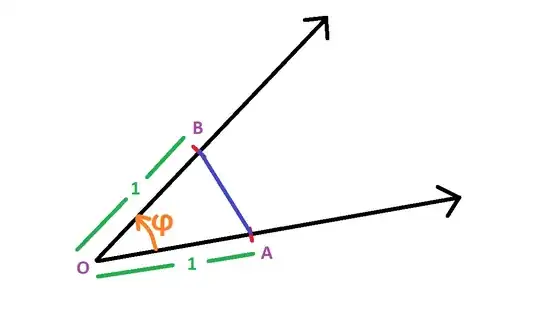The three basic angle measurement systems i.e. sexagesimal, centesimal and circular systems are based on a common idea of measuring angles in terms of arc lengths and radii.
Some terminology :
An angle is formed by rotating a "side" about a point. The "side" that is rotated is called the initial side, the point about which it is rotated is called the point of rotation and the side that is obtained after rotating the initial side about the point of rotation is called the terminal side.
Measuring an angle means measuring the extent of rotation made by the initial side to become the terminal side.
Let's say that in a certain angle measurement system, the unit measure of an angle is equal to the length of the line segment joining two points $A$ and $B$ where $OA = OB = 1~\mathrm{unit}$ ($O$ is the point of rotation) and $A$ and $B$ lie on the initial and terminal sides respectively. For example :
I was wondering if this is a valid way of measuring angles and what its limitations could be.
I think that for an angle measurement system to be valid, it must be true that given the measure of an angle in that system, the angle should be uniquely identifiable and for every angle, the measure of that angle in that system should be unique.
This system would give the measure of all of $60^\circ, 420^\circ, -60^\circ,-420^\circ$ as $1$ but if we constrain this system to $[0^\circ,180^\circ]$ (or $[0,\pi]$), this should not be a problem. In that case, every angle would have a unique measure in this system lying tn the interval $[0,2]$ and for every given measure (in the interval $[0,2]$), the angle would be uniquely identifiable.
Let's denote one unit in this system as $1^a$. So, $1^a = 60^\circ = \dfrac\pi3$ but $2^a \neq 2(60^\circ)$ but rather $2^a = 180^\circ = \pi$. Similarly, $90^\circ = \dfrac 32 \times 60^\circ$ but in this measurement system, $90^\circ = (\sqrt 2)^a \neq \dfrac 32\times 1^a$.
So, unlike degree to radian conversion, where all one needs to do is multiply by a real number (the factor of conversion), the trig functions get involved here.
For an angle $\phi$ whose degree measure is $D$ i.e. $\phi = D^\circ$, the measure of that angle in this new system would be equal to $2\sin\bigg(\dfrac\phi2\bigg)$.
So, how valid is this system of measuring angles? Could it have been the "initial" system for measuring angles, instead of the sexagesimal system?
Thanks!
